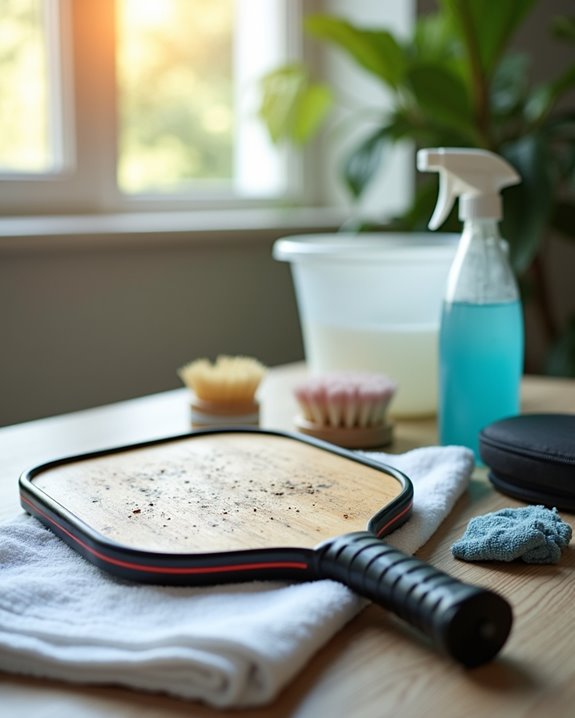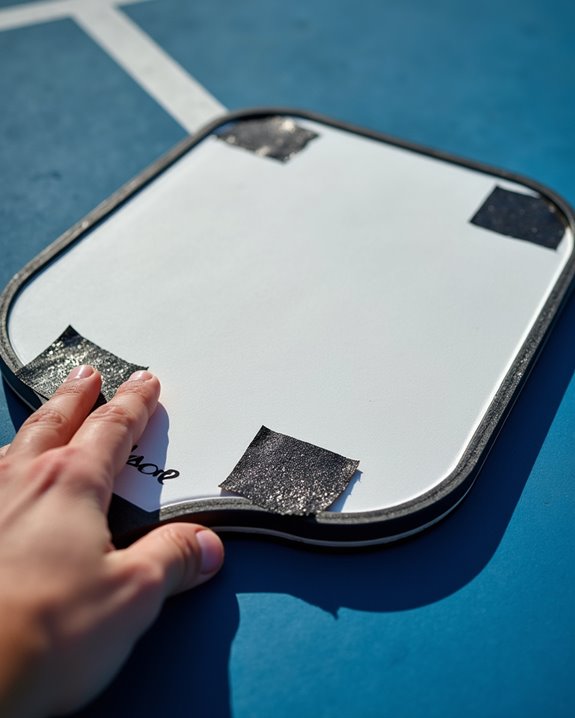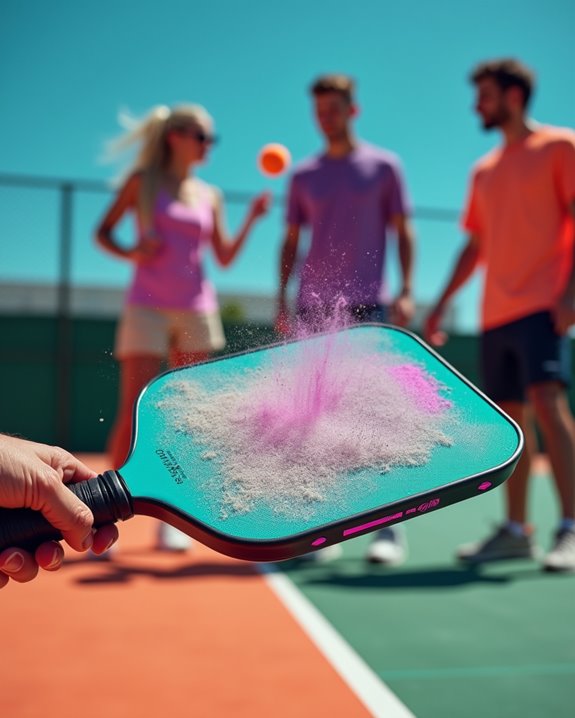To properly clean your pickleball paddle, follow these seven steps: gather supplies (microfiber cloth, cleaning solution), wipe down the paddle surface gently in circular motions, use a specialized eraser for carbon fiber paddles, refresh your grip with a damp cloth, inspect and clean the edge guard, allow complete drying time, and store in a cool, dry place. Regular maintenance keeps your paddle performing at its peak and extends its lifespan. Discover how these simple techniques can dramatically improve your game.
Key Takeaways
- Wipe the paddle surface with a damp microfiber cloth using circular motions to remove dirt and oils.
- Use glass cleaner for tough grime, but avoid harsh household cleaners that leave residue.
- Clean grip areas with a damp cloth and appropriate solution to maintain tackiness.
- Pay special attention to edge guards using a soft-bristled brush for stubborn dirt.
- Dry the paddle completely with a lint-free cloth before storing in a cool, dry place.
7 Steps to Clean Your Pickleball Paddle Properly
When your paddle starts losing its grip on the ball, it’s time for a proper cleaning session! Grab a damp microfiber cloth and an appropriate cleaning solution like glass cleaner to restore your paddle’s crisp performance.
When performance drops, a quick paddle cleaning with microfiber and proper solution works wonders to restore that crisp feel!
Gently massage the textured surface in circular motions—think of folding delicate ingredients rather than scrubbing a pan! You’ll want to lift dirt and grime without damaging the paddle’s spin-generating texture.
Don’t forget to freshen up the grip too! A quick wipe-down keeps it tacky and ready for action. After cleaning, pat everything completely dry before storing in a paddle cover.
Regular cleaning extends your equipment’s lifespan just like proper maintenance preserves a chef’s favorite knife. Store in a cool, dry place between your pickleball feasts!
Gather Your Cleaning Supplies
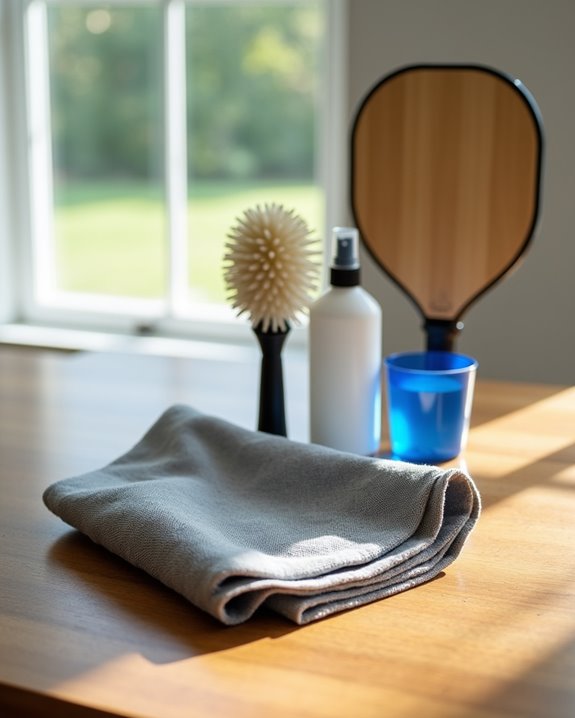
Now that you understand the cleaning process, let’s prepare your pickleball “mise en place”—gathering all the right tools before you begin! You’ll need a damp microfiber cloth as your primary utensil for properly cleaning your paddle’s surface without leaving scratches.
For tougher grime, have glass cleaner on standby—it cuts through dirt without those pesky sticky residues that attract dust. If you’re working with a carbon fiber paddle, fold in a specialized paddle eraser or carbon fiber cleaning block to your supply lineup. These tools gently lift unwanted fibers while preserving your paddle’s texture.
Don’t forget rubbing alcohol for those stubborn, sticky spots that resist your initial cleaning attempts. With these essential supplies assembled, you’re perfectly prepped to remove any dirt and restore your paddle to its pristine condition!
Wipe Down the Paddle Surface

The delicate surface of your pickleball paddle requires gentle yet thorough attention, much like seasoning a fine cast iron skillet. Take your damp microfiber cloth and gently wipe down the textured hitting surface with smooth, deliberate strokes, as if glazing a gourmet pastry. You’ll want to remove all dirt and debris without applying excessive pressure.
Skip household cleaners that leave performance-hindering residue—they’re as unwelcome as overcooked pasta. Focus your cleaning efforts on the paddle edges where grime tends to simmer and collect. After your initial wipe, follow with a dry microfiber cloth to absorb any lingering moisture, similar to patting dry a perfectly seared protein. Regular cleaning will maintain your paddle’s textured finish, ensuring your shots continue to slice through the air with professional precision.
Clean the Carbon Fiber With a Paddle Eraser
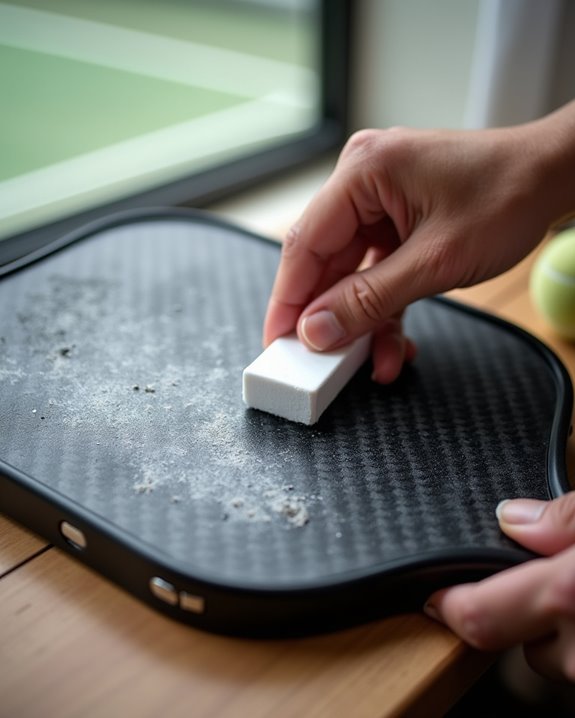
Carbon fiber paddles deserve special attention, much like a fine-grained cutting board that needs proper maintenance. To clean the carbon fiber effectively, use a specialized paddle eraser—your paddle’s best friend in the kitchen of pickleball maintenance.
Simply gently rub the eraser against the textured surface in circular motions, similar to folding egg whites into a soufflé. This technique lifts away stubborn dirt without damaging the delicate surface. No paddle eraser? A slightly damp, lint-free cloth works in a pinch.
Make this cleaning ritual part of your post-game routine. Regular maintenance removes surface dirt that can interfere with peak spin generation and ball control. Your diligence will enhance performance and extend lifespan, keeping your paddle crisp and responsive like a well-seasoned cast iron pan.
Refresh Your Paddle Grip
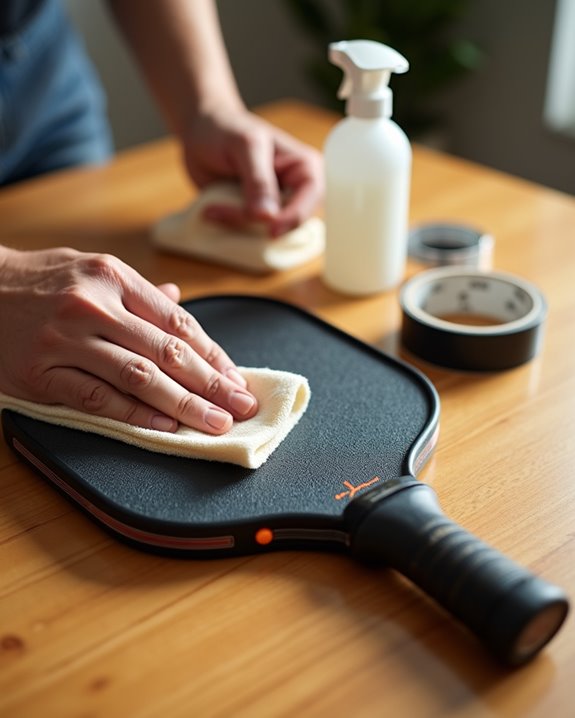
Gripping your paddle should feel as natural as holding your favorite chef’s knife—comfortable, secure, and responsive. Just like cleaning the hitting surface, maintaining your pickleball paddle grip regularly guarantees peak performance and prevents bacterial growth from sweat and dirt.
To refresh your grip, wipe it down with a damp microfiber cloth and a touch of glass cleaner—similar to deglazing a pan to remove stubborn bits. Confirm it’s completely dry before your next game to preserve that tacky feel.
When your grip feels slippery like an oiled skillet, it’s time to replace the grip. Wrapped grips need more frequent attention, while unwrapped versions have longer shelf lives. Consider adding an overgrip for a fresh feel—it’s like adding a new seasoning to revitalize your game!
Inspect and Clean the Edge Guard
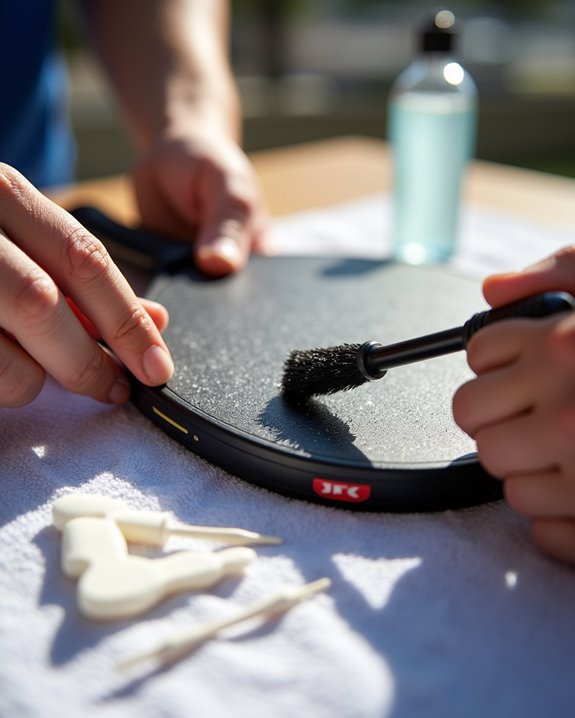
While you’re giving your paddle a thorough maintenance session, don’t forget about that essential perimeter protection—your edge guard deserves special attention! Begin with a visual inspection, looking for signs of wear, damage, or dirt that might be simmering beneath the surface.
Gently wipe the edge guard with a damp, lint-free cloth—think of it as delicately glazing a pastry. For stubborn grime baked into the grooves, fold in the use of a soft-bristled brush. Never use abrasive materials or harsh chemicals, which can corrode your paddle’s protective crust!
This simple maintenance recipe greatly extends your paddle’s longevity and preserves its structural integrity. Just like a well-seasoned chef’s knife, a clean edge guard ensures your paddle performs at its peak during every kitchen-line duel.
Allow Proper Drying Time
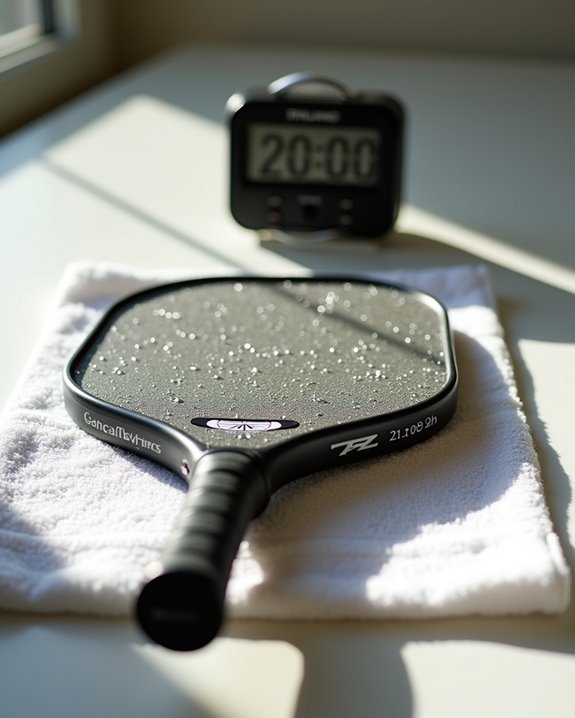
Once your edge guard is free from grime, you’re ready for the next step in your paddle care recipe—proper drying time. After cleaning the hitting surface with a damp microfiber cloth, place your paddle in a well-ventilated area and let it air-dry completely. This prevents moisture from getting trapped inside, which can cause core damage and reduce your performance on the court.
Don’t rush this process by using heat sources like hair dryers—these can warp your paddle materials like an overcooked soufflé! Wait at least 30 minutes before serving up your next game. This patience preserves the structural integrity and extends the lifespan of your paddle. Remember, proper drying is the secret ingredient to maintaining your equipment’s crisp response and powerful punch.
Frequently Asked Questions
How to Properly Clean a Pickleball Paddle?
You’ll extend your paddle’s longevity with proper cleaning techniques. Wipe the surface with a damp microfiber cloth for dirt removal, use a cleaning block on carbon fiber materials, and maintain grip care. Store covered for protection and performance.
How to Refresh a Pickleball Paddle?
To refresh your paddle, wipe the surface with a damp microfiber cloth, use a cleaning block for carbon fiber, and clean the grip with glass cleaner. Proper storage in covers extends paddle longevity while maintaining performance.
Does Water Damage Pickleball Paddles?
Yes, water exposure damages pickleball paddles. Moisture effects include delamination and reduced performance impact. For paddle longevity, avoid submerging, dry thoroughly after rain, and use proper cleaning solutions. Store in dry places for ideal paddle care.
Can I Use a Magic Eraser on a Pickleball Paddle?
Yes, you can use a Magic Eraser on your pickleball paddle. Dampen it slightly to prevent surface damage. This cleaning technique maintains paddle material integrity, extends paddle lifespan, and improves performance impact through regular care.

